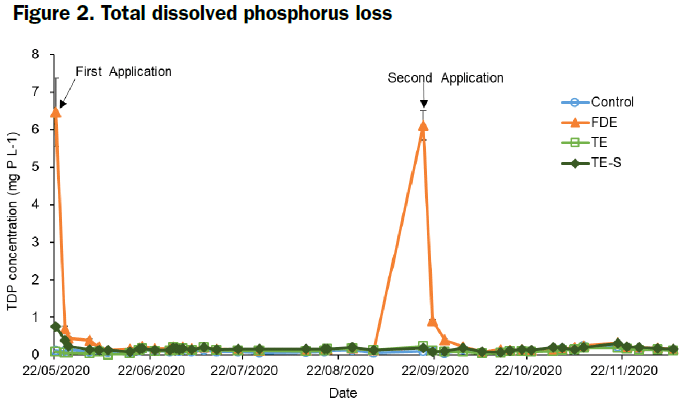An effluent treatment system has been found to significantly cut the risk of waterway contamination through tile drains. Anne Lee reports.
Trying to safely apply effluent on farms with subsurface drains can be a headache with the drainage system heightening the risk of phosphate (P) and E. coli loss.
 Subsurface drains, such as tile drains, are efficient at whisking excess water away from paddocks but they can also act as highways for nutrients and contaminants, directing them into waterways.
Subsurface drains, such as tile drains, are efficient at whisking excess water away from paddocks but they can also act as highways for nutrients and contaminants, directing them into waterways.
But Lincoln University scientists have found that an effluent treatment solution they’ve been working on can drastically cut P and E. coli losses even when subsurface drains have been installed.
The findings could have significant ramifications for areas where extensive drainage is present, helping simplify management and dramatically reduce the potential for nutrient and bacteria to get into waterways.
A high number of waterways including lakes are susceptible to P inputs with any increases in P concentrations likely to promote algal growth.
The latest research on the effluent treatment system has just been published in the scientific journal, Soil Use and Management.
Lincoln University PhD student Xueying Che carried out the studies, in conjunction with Professor Hong Di and Emeritus Professor Keith Cameron, using lysimeters designed to mimic an area where subsurface drainage had been installed.
The drainage collection point at the bottom of the lysimeters was overlayed with 55cm of gravel which in turn was overlayed by a 15cm layer of soil in which pasture was growing.
Xueying used fresh effluent and treated it with the same active ingredient and methods used in the Lincoln University and Ravensdown-developed ClearTech and EcoPond system.
Those treatment systems use polyferric sulphate, also commonly used in drinking water treatment plants.
In the ClearTech system, the treatment occurs in a large tank and separates clarified water from the treated effluent, making the clarified water available for yard washdown. The concentrated treated effluent has been proven to show reduced levels of P and E. coli leaching loss through soil.
The EcoPond system treats the effluent “in-line” on the way from the farm dairy to the storage pond providing the same reductions in P and E. coli loss potential through soil but without the clarified water capture.
Until Xueying’s work, the ClearTech and EcoPond research had looked at leaching losses through soil but Xueying aimed to find out what effect the treatments would have on leaching losses through subsurface drains given they are typically topped with a gravel layer.
She says it was already known from previous studies that treating the effluent with polyferric sulphate sets up a chemical reaction which transforms water soluble P into less-soluble, more stable forms of iron phosphate.
These forms of phosphate are more readily held by soil particles, but in a situation where soils have been drained there’s a gravel layer to contend with which has virtually no capacity to hold back nutrients.
To test the effects on soils with tile drains Xueying applied the treated effluent to the surface of the lysimeters on the same day it was treated.
She also applied it after it had been treated and then stored for eight weeks simulating both situations that would occur onfarm.
She applied untreated effluent as a comparison and plain water as a control.
Two applications took place for each of the four situations – one in May and the other in September.
Xueying applied spray irrigation following the May treatment so it supplemented rainfall and created conditions similar to those at the 75th percentile of winter rainfall records.
Irrigation over the summer period – to early December – followed typical irrigation patterns for Canterbury.
Xueying collected the drainage samples every week or more often if there were periods of higher rainfall and analysed the samples for total P, dissolved reactive P (DRP) and total dissolved P (TDP) as well as E. coli.
She also measured pasture production on the lysimeters.
The results
Compared with applying untreated effluent she found the loss of DRP was reduced by 93% when the effluent had been treated and reduced by 92% when it had been treated and then stored.
The TDP losses were 87% lower for treated effluent and 83% lower for treated and stored effluent when compared with untreated effluent.
Total P losses were 60.5% lower for treated effluent and 45% lower for the treated and stored effluent when compared with untreated effluent.
Total E. coli losses to drainage water were almost nil with reductions at 98% for treated effluent and 99.99% for treated and stored effluent compared with untreated effluent.
Pasture growth was unaffected by the different treatments confirming P is still available to plants while being protected from leaching loss.
Xueying says the storage of the effluent didn’t appear to diminish the effectiveness of the treatment on limiting nutrient losses. She believes the lower total P loss reductions found when compared with previous studies using lysimeters could be attributed to the differences in the depth of soil between those studies and hers.
In her study the soil was 15cm deep whereas in other lysimeter studies the soil has been 70cm deep giving greater capacity for the iron phosphate to be held in the soil. Cameron says the research team hoped Xueying’s research findings will give farmers confidence the new technology will help them reduce farming impacts on water.
“With farm environment plans and new freshwater plans expected to demonstrate action to reduce nutrient losses to water, this technology provides a new tool for farmers to reduce phosphate loss and E. coli loss to water, especially those with subsurface drains,” he says.





